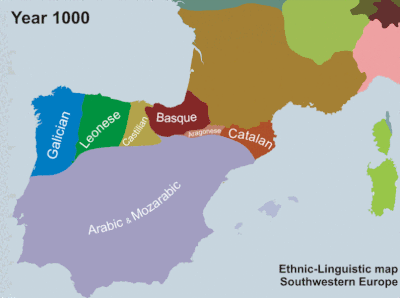Galician-Portuguese language: Difference between revisions
George Swan (talk | contribs) (never mind) Tag: Undo |
George Swan (talk | contribs) (add image) |
||
| Line 1: | Line 1: | ||
{{subpages}} | {{subpages}} | ||
[[File: | [[File:Linguistic map Southwestern Europe-en.gif | thumb | 400px | This animated map shows the southward growth of [[Romance languages]], like the Galician-Portuguese languages, as Christian rule displaced muslim rule..]] | ||
'''Galician-Portuguese''' (in its own language: ''galegoportuguês, galaico-português'') is a [[Romance language]] spoken mainly in [[Galicia (Spain)|Galicia]], [[Portugal]], [[Brazil]] and various countries of Africa and Asia, with two main standardized varieties: | '''Galician-Portuguese''' (in its own language: ''galegoportuguês, galaico-português'') is a [[Romance language]] spoken mainly in [[Galicia (Spain)|Galicia]], [[Portugal]], [[Brazil]] and various countries of Africa and Asia, with two main standardized varieties: | ||
*'''[[Galician language|Galician]]''' ''(galego)'' in Galicia | *'''[[Galician language|Galician]]''' ''(galego)'' in Galicia | ||
Revision as of 05:12, 21 August 2022

Galician-Portuguese (in its own language: galegoportuguês, galaico-português) is a Romance language spoken mainly in Galicia, Portugal, Brazil and various countries of Africa and Asia, with two main standardized varieties:
- Galician (galego) in Galicia
- Portuguese (português) in the other countries.
Some authors even call “Portuguese” the whole Galician-Portuguese set.
The language was born in the High Middle Ages in Galicia and northern Portugal before it was spread in the rest of Portugal by the Reconquista. It enjoyed a unitary development during the Middle Ages. An apparent split between Galician and Portuguese occurred in the 15th century because Galicia became strictly controlled by the centralized power of Castile (then Spain), while Portugal was a dynamic, independent nation. So Galician became a minority language subjugated by Spanish while Portuguese went on thriving freely and was even spread overseas. Nonetheless, Galician and Portuguese have kept a strong linguistic unity.
Since the 20th century, the question whether Galician should be codified or not in accordance with Portuguese has lead to two rival norms: one is very similar to that of Spanish; the other one stresses Galician tradition and is very similar to that of Portuguese.
The codification of Portuguese is fully autonomous. It has suffered minor discrepancies between Brazilian Portuguese and the other Portuguese varieties, but they are now reduced in an ongoing process of harmonization.